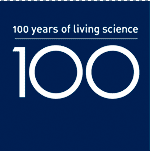Peter Ackers
(Civil Engineering, 1942-44)
shares his memories of civil engineering at Imperial
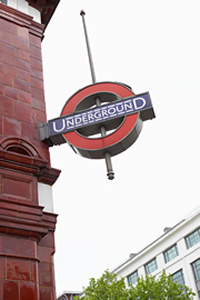 Being a working class lad from Merseyside, I could not have had a university education but for the opportunity of obtaining a scholarship and grants from the local education authority. I was advised to try for one of the few Royal Scholarships awarded each year - and I was lucky. I had never been to London before and so this was a step into the unknown for me. It had been possible to arrange digs near the college, in Eccleston Place, which was about half a mile from college. Arriving at Euston by train, I was faced with finding my way to South Kensington with my suitcase, with no prior knowledge of the underground system and we working class folks had not been brought up to use taxis which were considered an expensive luxury. Anyway, I found someone who volunteered the information that I had to find my way to the Piccadilly line - or was it the Circle line I took. Too long ago to remember but my small room was on the top floor, really in the attic, with a little gas radiator with a lid at the top that opened to show a tiny gas ring, just right for making a supper drink. Breakfasts and evening meals were provided and we students had a table to ourselves in this boarding house. There was food rationing of course so our books of coupons were handed over to cover the meagre allowance of butter, sugar, cheese and meat.
Being a working class lad from Merseyside, I could not have had a university education but for the opportunity of obtaining a scholarship and grants from the local education authority. I was advised to try for one of the few Royal Scholarships awarded each year - and I was lucky. I had never been to London before and so this was a step into the unknown for me. It had been possible to arrange digs near the college, in Eccleston Place, which was about half a mile from college. Arriving at Euston by train, I was faced with finding my way to South Kensington with my suitcase, with no prior knowledge of the underground system and we working class folks had not been brought up to use taxis which were considered an expensive luxury. Anyway, I found someone who volunteered the information that I had to find my way to the Piccadilly line - or was it the Circle line I took. Too long ago to remember but my small room was on the top floor, really in the attic, with a little gas radiator with a lid at the top that opened to show a tiny gas ring, just right for making a supper drink. Breakfasts and evening meals were provided and we students had a table to ourselves in this boarding house. There was food rationing of course so our books of coupons were handed over to cover the meagre allowance of butter, sugar, cheese and meat.
Photo right: London Underground sign
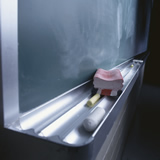 I actually started at City and Guilds a month before term proper opened because to be an engineer I needed a knowledge of machine drawing. The few who came via apprenticeship schemes and perhaps a Whitworth Scholarship had already done this but the rest of us needed to know all about projections and screw threads and the like, hence this month extra. I was good at drawing anyway so this was no problem to me. The first day of real term, we had someone from the armed services who explained our role in no uncertain terms. We had been selected to be future scientists and technicians and were therefore exempt from the call-up, but, as these specialists would be so important to the war effort, we had no choice in the matter. Anyone who felt like volunteering despite their exemption would be brought back to finish the course. The degree course would be squeezed into two years so we were going to have to work long hours and hard and any thought of university being an easy few years was out of the question. So I was at university doing my civil engineering for only two years. The first year covered mechanical and electrical engineering as well, because our later careers might have required those extra disciplines. We had lectures every weekday of course, interspersed with practical work in the workshops or laboratories, and study periods when we worked under supervision doing exercises or drawing up schemes. So we covered such things as practical concrete mixing, testing steel samples until they broke in the powerful test machines, hydraulic experiments on weirs in the water lab., surveying in Kensington Gardens, the efficiency of internal combustion engines and tests on electric motors. Thus it was quite a wide and very practical training, with some excellent professors and lecturers teaching us all the theory, including more advanced maths than we had learned at school. We had used slide rules in the sixth form and these were essential in doing structural designs etc. Our maths lecturer was so nearly blind that he would write long equations over the width of two blackboards on vertical runners and didn’t know that we were utterly foxed when he pushed one side up to make more room!
I actually started at City and Guilds a month before term proper opened because to be an engineer I needed a knowledge of machine drawing. The few who came via apprenticeship schemes and perhaps a Whitworth Scholarship had already done this but the rest of us needed to know all about projections and screw threads and the like, hence this month extra. I was good at drawing anyway so this was no problem to me. The first day of real term, we had someone from the armed services who explained our role in no uncertain terms. We had been selected to be future scientists and technicians and were therefore exempt from the call-up, but, as these specialists would be so important to the war effort, we had no choice in the matter. Anyone who felt like volunteering despite their exemption would be brought back to finish the course. The degree course would be squeezed into two years so we were going to have to work long hours and hard and any thought of university being an easy few years was out of the question. So I was at university doing my civil engineering for only two years. The first year covered mechanical and electrical engineering as well, because our later careers might have required those extra disciplines. We had lectures every weekday of course, interspersed with practical work in the workshops or laboratories, and study periods when we worked under supervision doing exercises or drawing up schemes. So we covered such things as practical concrete mixing, testing steel samples until they broke in the powerful test machines, hydraulic experiments on weirs in the water lab., surveying in Kensington Gardens, the efficiency of internal combustion engines and tests on electric motors. Thus it was quite a wide and very practical training, with some excellent professors and lecturers teaching us all the theory, including more advanced maths than we had learned at school. We had used slide rules in the sixth form and these were essential in doing structural designs etc. Our maths lecturer was so nearly blind that he would write long equations over the width of two blackboards on vertical runners and didn’t know that we were utterly foxed when he pushed one side up to make more room!
Of course many of my student colleagues were from a different part of society than I came from, many from public schools. Class differences were never a barrier and, being the one with the highest entry qualification in the group, I was always treated with respect. They would ask me questions in the study classes rather than the tutor: was this to hear my strange ‘scouse’ accent or because I could explain things clearly? I wonder! Many of them came from wealthy and reputable families. Stopes-Roe, for example, was the son of Marie Stopes, the outspoken feminist of her day who pressed for better information about birth control. The Roe in his name was from A. V. Roe, the aircraft manufacture Avro. One student even had been able to build his own wind tunnel in the conservatory of the house where he lived to test model aeroplanes! Most of the students were fee paying as their parents were of ample means but all had to have good A-level results to gain entry to probably the best technical university in the country (Cambridge was more for pure sciences and arts, and Oxford’s reputation was in the arts too). There were quite a few grammar school students with their local awards to support them and my best friend there was Frank Sibley, who was from Manchester Grammar School, and was later to ask me to be his best man. Peter Andrews was another good friend who was from south Wales and came with a Whitworth Scholarship.
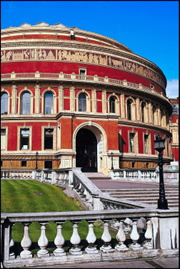 We all had extra duties for the war effort. Many of those from public schools had been in the Army Cadets or the Air Cadets so they were seconded to serve in the Home Guard or continue their air force training. I was told to become an air raid warden, reporting to a unit in the basement of the block of mansions opposite the back of the Albert Hall. I was issued with a black battledress uniform, a black tin hat with a white W on it, and a greatcoat. It was there that I had my closest shave of the war, because although Merseyside’s air raids were virtually over, London remained very vulnerable. There was a battery of heavy anti-aircraft guns in Hyde Park and on duty just by the Albert Hall one night there was the whine of falling shells just after the anti-aircraft guns let off a salvo. One, two, three four, five getting ever closer. I ducked by the wall not far from a telephone box. One of those shells actually knocked a pinnacle off a corner of the Albert Memorial, while the next hit the road, just beyond the heavy granite kerb stones and exploded. This probably saved me from injury, because it deflected the shrapnel upwards, breaking the upper panes in the telephone box and pock marking the wall above me. I was shaking like a leaf when I went to report back to base to the head warden, an ex-colonel.
We all had extra duties for the war effort. Many of those from public schools had been in the Army Cadets or the Air Cadets so they were seconded to serve in the Home Guard or continue their air force training. I was told to become an air raid warden, reporting to a unit in the basement of the block of mansions opposite the back of the Albert Hall. I was issued with a black battledress uniform, a black tin hat with a white W on it, and a greatcoat. It was there that I had my closest shave of the war, because although Merseyside’s air raids were virtually over, London remained very vulnerable. There was a battery of heavy anti-aircraft guns in Hyde Park and on duty just by the Albert Hall one night there was the whine of falling shells just after the anti-aircraft guns let off a salvo. One, two, three four, five getting ever closer. I ducked by the wall not far from a telephone box. One of those shells actually knocked a pinnacle off a corner of the Albert Memorial, while the next hit the road, just beyond the heavy granite kerb stones and exploded. This probably saved me from injury, because it deflected the shrapnel upwards, breaking the upper panes in the telephone box and pock marking the wall above me. I was shaking like a leaf when I went to report back to base to the head warden, an ex-colonel.
Photo above: The Albert Hall
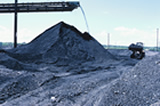 During the summer vacation between our two years we were required to get practical experience whilst helping the war effort. I was allocated to work on an open cast coal mine near Wakefield, where I had digs in a cottage in nearby woods, so it was very much an outdoor period. The open cast workings consisted of taking out the soil and soft rock above the coal seams using big scrapers pulled by caterpillar tractors, which dug up perhaps 20 or 30 tons each go, transporting this material to a spoil heap. Then dragline machines would dig up the coal seam loading the coal into lorries that went off to power stations or wherever. My job was to assist a Welshman in surveying because the contractor was being paid so much for every cubic yard of spoil and every cubic yard of coal he excavated. Accuracy of surveying was all important and then it all had to be plotted on plans and the volumes worked out, using a planimeter to measure the irregular areas involved. This was all quite enjoyable when the weather was OK and I learned a lot from the practical engineer I was with.
During the summer vacation between our two years we were required to get practical experience whilst helping the war effort. I was allocated to work on an open cast coal mine near Wakefield, where I had digs in a cottage in nearby woods, so it was very much an outdoor period. The open cast workings consisted of taking out the soil and soft rock above the coal seams using big scrapers pulled by caterpillar tractors, which dug up perhaps 20 or 30 tons each go, transporting this material to a spoil heap. Then dragline machines would dig up the coal seam loading the coal into lorries that went off to power stations or wherever. My job was to assist a Welshman in surveying because the contractor was being paid so much for every cubic yard of spoil and every cubic yard of coal he excavated. Accuracy of surveying was all important and then it all had to be plotted on plans and the volumes worked out, using a planimeter to measure the irregular areas involved. This was all quite enjoyable when the weather was OK and I learned a lot from the practical engineer I was with.
Photo above: Coal mine
I was still doing my duties at the Albert Hall warden’s post in the second year at college, but the South Kensington digs were not available so I found some in south west London, in West Norwood, with a train journey to get to college each day. This was in a pleasant semi, the home of an elderly lady with two spare rooms. The other was occupied by Squadron Leader Boyce, a New Zealander on duty at the RAF headquarters in Whitehall. I remember being surprised at the spring beauty of the almond and cherry blossom on the trees flanking the roads: we had not seen much of that in Bootle! My good friend Frank Sibley was in digs not far away and we always met on Saturdays, usually finishing up in the cinema, if there was anything worthwhile on. If there were air raids when I was at the digs, I considered myself to be available for duty, and there was a phase of fire bomb attacks. Like most students, however, my philosophy was to stay in bed to sleep if I could, expecting to just have time to slip out of bed and lie alongside if I heard a bomb dropping close. During one firebomb raid I heard the sound of falling incendiaries so put on my greatcoat and tin hat to see if any were close enough to put us at risk. By then the Germans had made a proportion of their fire bombs also anti-personnel devices, and the information was that they should not be tackled for seven minutes after impact, judged to be the maximum delay on the fuses. Seven minutes being up I left the house. The only incendiary in sight was in the road so could be left to burn itself out, but I could see by the glow that there were others in the next street around the corner. There was an auxiliary fire station there and the volunteer crews were stood outside wondering what to do when I was met by a man saying there was a bomb on the roof of their block of flats. Could I help? All sizeable buildings had a rota of fire watchers, and theirs was getting organised when I got to the top floor of either a four or five storey block. Someone had got a ladder up to the roof access hatch so up I went. I was given the stirrup pump as they thought, wearing a warden’s helmet and being young, I was best trained to deal with the problem. All household and buildings had their hand-operated stirrup pumps which operated from a bucket of water. You needed a team of three or more to use them: One to direct the jet, one to pump and at least one but really a team, to form a chain of water carriers. The procedure for the hose man - me - was to take aim when lying down but to hide behind a bin lid held in the other hand when actually directing the spray onto the bomb, in case it burst in a spray of burning phosphorus. The pump man was as far away as allowed by the length of hose. We were working efficiently as a team when the message came that the auxiliary fire crews had got one of their trailer pumps working and were about to send a jet up to the roof. We should leave them to it, which we were very happy to do. This was just the spirit of the day. Urgent decisions were taken without delay or discussion. People who had never met before and would never meet again probably just did what was necessary and some sort of leader would quickly emerge.
We are now in about the middle of June 1944. There had been rumours of German secret weapons for some time, but most people, like me, took them as propaganda. I think it was a Friday night about 13 June that we learned that it was not just propaganda. There was a raid during the night and the planes we heard had a different sound from the usual one-second throb of the normal twin engined German bomber. The explosions they produced were earth shaking too. I met my friend Frank the next day, enquired how he had got on during the night - a noisy night but OK. We met up with a college friend just by chance and he was still shaking and told us the news: this was Hitler’s secret weapon, which came to be known by its German code as the V1. He heard the thunderous crackle of an aircraft engine, sat up in bed, saw the flames from its ramjet engine as it passed his window, pulled the eiderdown over his face and bang, the windows shattered, the wardrobe was stuck with splinters of glass, he cut his feet getting out of bed. The flying bomb, the forerunner of the cruise missile, had flown into the pair of houses forming the end of the cul-de-sac, demolishing them and the neighbouring houses and killing everyone living there. No wonder he was shaking and that was the end of my scepticism about the German ability to develop a completely new weapon. Being to the south east of London, we and all the other suburbs there were very vulnerable as many of the V1’s fell short of central London. They had a timer which switched off the engine when their speed should have got them somewhere over a populated area, when they dived into the ground to explode on impact giving a great deal of blast damage.
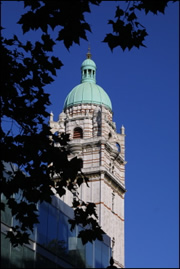 Time for our finals was approaching, however, which were taken in the Imperial Institute Buildings at Imperial College, only the tower of which remains. Instructions included that if the air raid sirens sounded, we were to keep going. There was no question of us going to shelters, but if we heard a bomb coming close we could duck! If there was a direct hit, too bad! Luckily there was a lull that week. Of course the V1’s were not restricted to night raids and when one heard one, you listened for the engine to stop and if it passed you by it was some other poor soul’s turn. I well remember being on a bus going along Hyde Park Road when we heard a V1. The bus conductor leaned out at the back and watched it fly past and then shouted that we were OK. You can’t imagine that attitude being allowed today with the police seeming to stop ordinary life and traffic and keep it stopped to avoid the slightest risk.
Time for our finals was approaching, however, which were taken in the Imperial Institute Buildings at Imperial College, only the tower of which remains. Instructions included that if the air raid sirens sounded, we were to keep going. There was no question of us going to shelters, but if we heard a bomb coming close we could duck! If there was a direct hit, too bad! Luckily there was a lull that week. Of course the V1’s were not restricted to night raids and when one heard one, you listened for the engine to stop and if it passed you by it was some other poor soul’s turn. I well remember being on a bus going along Hyde Park Road when we heard a V1. The bus conductor leaned out at the back and watched it fly past and then shouted that we were OK. You can’t imagine that attitude being allowed today with the police seeming to stop ordinary life and traffic and keep it stopped to avoid the slightest risk.
Photo above: Queen's Tower
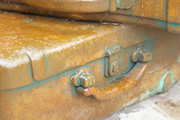 Before the course came to the end, the Germans had unleashed their much more advanced secret weapon, the V2, a ballistic missile based on liquid fuelled rockets with sufficient range to reach London. There was no defence, no possibility of warnings, just a double bang which, if you heard, you knew you were safe. Some mis-information was put out to persuade the enemy that they were all overshooting the centre of the capital and this may have caused them to slightly shorten the trajectory to compensate. Anyway, it was the east and south-east suburbs which really suffered. By then, the V1 attacks had ceased. They could by shot down by heavy concentrations of anti-aircraft guns and the most modern Spitfires could just about catch them and tip them over to crash early. But the V2’s were only defeated when their launch sites or supply route from the underground slave labour camps where they were made were damaged by allied air raids. When my course was finally over, I could take a very short holiday at home before coming under the scheme for the direction of labour, which affected every adult. I had left a small suitcase with text books in it with Squadron Leader Boyce to take care of with the intention of collecting it when next in the London area, but when I went for it a couple of weeks later, getting off the train at West Norwood the landscape was quite different. There was a wide open space, at the very edge of which was my old digs. Windows had gone and the front door was propped against its frame with a note on it. ‘Would Peter Ackers please go to the RAF headquarters in Whitehall and ask for Mr Boyce.’ The lady who had lived there had also fortunately escaped with her life. That was a V2, so I was still lucky.
Before the course came to the end, the Germans had unleashed their much more advanced secret weapon, the V2, a ballistic missile based on liquid fuelled rockets with sufficient range to reach London. There was no defence, no possibility of warnings, just a double bang which, if you heard, you knew you were safe. Some mis-information was put out to persuade the enemy that they were all overshooting the centre of the capital and this may have caused them to slightly shorten the trajectory to compensate. Anyway, it was the east and south-east suburbs which really suffered. By then, the V1 attacks had ceased. They could by shot down by heavy concentrations of anti-aircraft guns and the most modern Spitfires could just about catch them and tip them over to crash early. But the V2’s were only defeated when their launch sites or supply route from the underground slave labour camps where they were made were damaged by allied air raids. When my course was finally over, I could take a very short holiday at home before coming under the scheme for the direction of labour, which affected every adult. I had left a small suitcase with text books in it with Squadron Leader Boyce to take care of with the intention of collecting it when next in the London area, but when I went for it a couple of weeks later, getting off the train at West Norwood the landscape was quite different. There was a wide open space, at the very edge of which was my old digs. Windows had gone and the front door was propped against its frame with a note on it. ‘Would Peter Ackers please go to the RAF headquarters in Whitehall and ask for Mr Boyce.’ The lady who had lived there had also fortunately escaped with her life. That was a V2, so I was still lucky.
Photo above right: Suitcase
Having started with a very good education in science and maths from school, I had no difficulty in keeping up with the work at university and I had learned good examination technique early on so finished with a good degree and was awarded the Henrici Medal for mathematics, the Unwin Medal for overall performance, and to add to those awarded after the first year, the Coopers Hill Medal and John Samuel prize. These medals include some fine examples of Art Deco design as well as traditional, perhaps Victorian designs. Of course wartime meant that there were no opportunities for post-graduate study or university research, so my whole career was based on just two years actually at university.
During this time, the college was obviously involved in research for the war effort. In the long corridor in the basement of the old red brick building, which was definitely out of bounds to students, one would occasionally see a string of big gas burners in operation, and I think the word went round that it was something to do with dispersing fog from airfields. Fido was the acronym, of course. No doubt other research was under way too. I remember going home one late afternoon and happening to sit next to one of the professors from the Royal College of Science on the front seat of the top deck of a bus. He was busy with some complex maths and, when I asked him what he was working on, he suddenly realised his work could be overlooked. He quickly hid his papers away and changed the subject. Was he involved with the programme to develop a nuclear weapon? I have often wondered.
(Extract from; My World: the Life and Times of a Civil Engineer, published by The Memoir Club.)
© 2007 Imperial College London
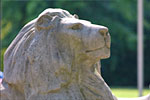
Through the first decade of the twenty-first century the campaign seeks to philanthropically raise £207 million from Imperial’s alumni, staff and friends, and donations from charitable foundations and industry.
Where your support can make a differenceGive now

Imperial’s Centenary Year provides an opportunity to recognise and celebrate members of the Imperial community.
View staff and student portraits
